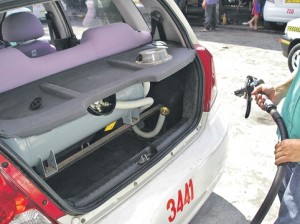The government needs to tighten its monitoring of the way taxis are fitted with liquefied petroleum gas (LPG) kits to prevent health hazards to cab drivers and their passengers.
Deputy presidential spokesperson Abigail Valte said the Aquino administration was pushing for the use of alternative energy sources to lessen dependence on petroleum products. But she said that vigilance and compliance with standards were required to avoid health risks posed by LPG-powered cabs outlined in a Philippine Daily Inquirer special report—“Toxic Taxis.”
“We should make sure there will be no adverse effects on drivers and their passengers,” Valte said.
The problem is several agencies are involved in the operation of LPG-driven vehicles and the Department of Energy (DOE) claims it has no jurisdiction on this.
Zenaida Y. Monsada, director of the DOE’s Oil Industry Management Bureau, explained that the energy department’s role was primarily to ensure adequate supply, strict compliance with the standards on the retail gas station level, and technology promotion and development.
The Department of Trade and Industry (DTI) oversees the accreditation of LPG-conversion centers and shops, as well as the setting of standards for cylinder quality and the conversion processes, she said, while the Department of Transportation and Communications (DOTC) is in charge of the registration and the labeling of vehicles, she said.
Flaky conversion process
According to Monsada, the problems arising from the use of LPG to fuel vehicles can be traced primarily to the conversion process, noting that “maraming palpak na (many are incompetent) conversion centers,” a lot of which are no longer operating.
Monsada did not want to point at a particular agency to blame for these issues, but only noted that while “there are areas of cooperation, each department has its own tasks to oversee.”
She expressed apprehension over reports of incidences of respiratory problems associated with the use of LPG-run vehicles as it could affect the country’s energy plan.
But she cited a previous report from the Department of Health (DOH) which said that LPG for vehicles was safe and that “there were no known adversarial effects associated with chronic exposure to the component of LPG.”
Leak protection device
“There was a suggestion though to increase device leakage protection and beef up the quality of existing standards for tanks,” Monsada said.
While the issue does not fall within the DOE’s jurisdiction, it might have an effect on the government’s energy program, she said.
Monsada explained that initially, the use of LPG to fuel vehicles was largely a private-sector initiative. During the pre-oil deregulation days, she said the use of auto-LPG was not encouraged by the government because of potential supply problems and inadequate infrastructure.
The passage of the Oil Deregulation Law in 1998, however, paved the way for more oil companies, including distributors of LPG, to invest in the fuel distribution network in the Philippines. Auto-LPG is now being distributed by Liquigaz, Total Philippines, Pryce Gases, and Petronas Petron Corp. and Pilipinas Shell Petroleum, the two biggest oil companies in the Philippines, also sell auto-LPG.
With the entry of the oil companies, the DOE decided to incorporate the use of LPG in the energy plan, backed by an inter-agency collaborative effort, which involved the DOE, DTI, DOTC and its subagencies and even the Department of Science and Technology.
